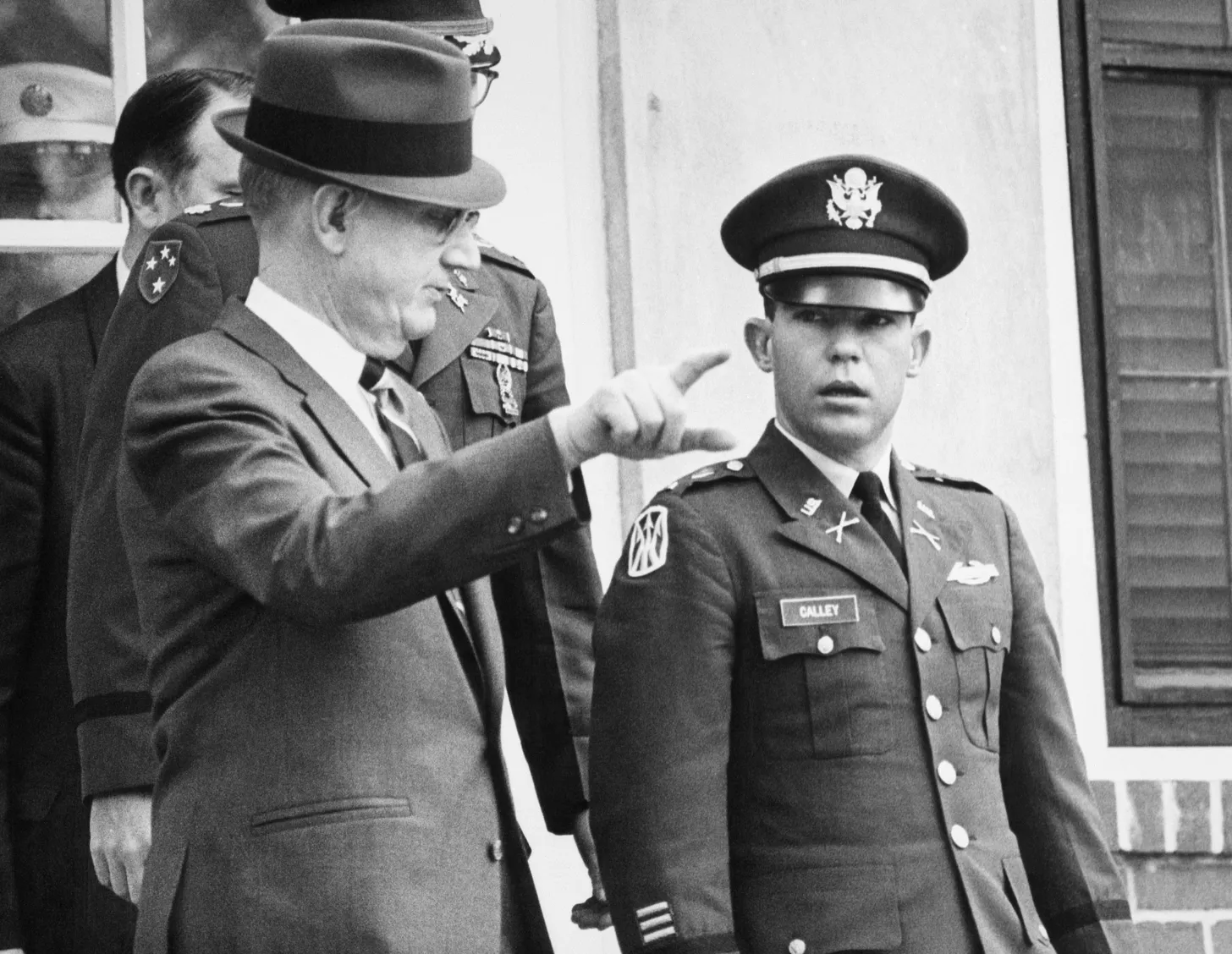Civilian defense attorney George Latimer speaks to his client Army Lieutenant William Calley as they leave a court-martial hearing.
At 6 am or so, Calley told me that his much admired company captain, a guy named Ernest Medina, who was known to his troops, I would later learn, as “Mad Dog Medina,” was also at Fort Benning awaiting legal proceedings. Medina would tell me, Calley said, that all he had done at My Lai came pursuant to Medina’s direct orders. He dialed a number, and Medina—about whom I knew nothing—picked up immediately. Calley explained that a reporter from Washington was on the phone with him.“Please, Captain,” Calley said, “tell him what I did was under your orders.”
“I don’t know what you are talking about,” Medina said, and he hung up. Calley was stricken.
It was clear that he’d just figured out that he would be the sacrificial lamb. The bad apple. It would all be on him. The generals and colonels and captains who planned the slaughter—to get a high body count in the war and make the generals in Saigon and Washington happy—were going to ride into the sunset.
I was totally exhausted. I told him I had to leave. Calley, in a panic, said: “Let’s go bowling.”
It couldn’t happen. I left, got to the airport, took a plane to Washington, and, exhausted as I was, I began writing the first of what would be five stories over the next months about what happened at My Lai.
-
Neueste Beiträge
- 27.10.1967, Baltimore Four
- Hilde Coppi
- Der Eindruck, als hätten sie den Verstand verloren
- Jeremy Loffredo on seizure by Israelis and lack of response from US embassy
-
- Kamala Harris is an offense against the truth, against reality and against justice itself.
- No joints at the breakfast table without being able to change the tire on my truck.
- The next President of the United States will hurt the American people, and they will have earned this.
Archive
- Oktober 2024
- September 2024
- August 2024
- Juli 2024
- Juni 2024
- Mai 2024
- April 2024
- März 2024
- Februar 2024
- Januar 2024
- Dezember 2023
- November 2023
- Oktober 2023
- September 2023
- August 2023
- Juli 2023
- Juni 2023
- Mai 2023
- April 2023
- März 2023
- Februar 2023
- Januar 2023
- Dezember 2022
- November 2022
- Oktober 2022
- September 2022
- August 2022
- Juli 2022
- Juni 2022
- Mai 2022
- April 2022
- März 2022
- Februar 2022
- Januar 2022
- Dezember 2021
- November 2021
- Oktober 2021
- September 2021
- August 2021
- Juli 2021
- Juni 2021
- Mai 2021
- April 2021
- März 2021
- Februar 2021
- Januar 2021
- Dezember 2020
- November 2020
- Oktober 2020
- September 2020
- August 2020
- Juli 2020
- Juni 2020
- Mai 2020
- April 2020
- März 2020
- Februar 2020
- Januar 2020
- Dezember 2019
- November 2019
- Oktober 2019
- September 2019
- August 2019
- Juli 2019
- Juni 2019
- Mai 2019
- April 2019
- März 2019
- Februar 2019
- Januar 2019
- Dezember 2018
- November 2018
- Oktober 2018
- September 2018
- August 2018
- Juli 2018
- Juni 2018
- Mai 2018
- April 2018
- März 2018
- Februar 2018
- Januar 2018
- Dezember 2017
- November 2017
- Oktober 2017
- September 2017
- August 2017
- Juni 2017
- Mai 2017
- April 2017
- März 2017
- Februar 2017
- Januar 2017
- Dezember 2016
- November 2016
- Oktober 2016
- September 2016
- August 2016
- Juli 2016
- Juni 2016
- Mai 2016
- April 2016
- März 2016
- Februar 2016
- Januar 2016
- Dezember 2015
- November 2015
- Oktober 2015
- August 2015
- Juli 2015
- Juni 2015
- April 2015
- Januar 2015
- Dezember 2014
- November 2014
- Oktober 2014
- September 2014
- Juli 2014
- Juni 2014
- Mai 2014
- April 2014
